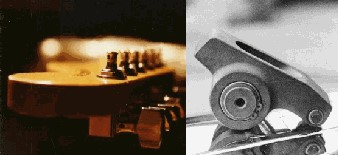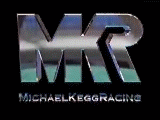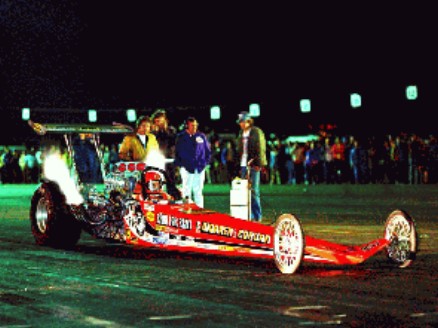



Of extreme importance are the connecting rods and pistons. Sharp edges on the piston domes can cause pre ignition detonation as they get hot and glow literally, and should be carefully smoothed. All pistons should weigh as much as the lightest piston, and can usually be lightened by removing material from the balancing pads on the underside of the pistons, where the wrist pins are located. These parts may have further material removed from the balancing pads when they are dynamically balanced, as I will mention later. Connecting rods are the most critical of parts to modify. You can remove the forging lines to blend into the rod by grinding, if extreme care is used not to remove too much material during the blending. If you look at a set of Bruce Crower Forged Steel Racing Connecting Rods you can see what I mean. If you are too afraid to modify and run stock forged connecting rods, and have the money, give it to Bruce. You make all the rods weigh as much as the lightest rod, removing material from the balancing pads located usually on top, above the wrist pin bore, and on the bottom, on the rod cap. Use only the finest new rod bolts and nuts available. The words Boron Steel come to mind. Find the best and pay the price. Rod bolts are so critical, racing shops torque them while measuring rod bolt stretch. If one bolt is too stretchy, the elastic pin is tossed in the trash can, after you destroy it with a hammer, to make impossible it’s accidental use.. You can get by, just applying the proper torque to the bolts at specifications, however cheap low quality rod bolts are just plain stupid. The best rod bolts are affordable. Be smart.
Remember to follow this basic engine rebuilding rule applicable to all engines. Every part must go back in the exact location it was taken from, even if the part is symmetrical mark them if need be. Meaning, the rod taken from the number one cylinder is returned to the same cylinder exactly. I mean totally exactly, thus defined as the rod face, which faces the front of the block, is returned the same way, not just getting the number one rod in the number one hole. Additionally whether or not the rod cap is symmetrical, it must be returned to the rod exactly as it was removed. The crankshaft bore end of the rod is machined with the rod bolted to the rod cap. Some parts are reusable with extreme care. You don’t need to buy a new block, heads, crankshaft, connecting rods, pistons etc., etc. every time you freshen up the engine if you take good care of them. That may sound arbitrary, but it can only be achieved by building an engine that does not grenade, or catastrophically fail, and knowing when to cease and desist from running it further to achieve that objective.
All engine parts should be thoroughly cleaned again, including and especially all those oil passages in the block and crankshaft, furthermore every thing should be carefully visually inspected and tested for fractures with Zyglo and Magna Flux, and or whatever you or they have, again to help ensure your engine does not grenade and scatter parts all over the place. At high R.P.M. small little stress cracks that could develop, but survive in a stock engine during normal operation, might turn into the San Andreas fault, and run like a piece of glass, and KaBoom, the next thing you know, your weeping into you wallet. Zyglo and Magna Flux may reveal any defect, hopefully. Once your reasonably sure your parts are up to the task and good to go, get your engine dynamically balanced. The person doing the balancing will need the pistons, wrist pins, connecting rods with bolts and nuts, crankshaft, harmonic balancer, and the flywheel or flex plate as the case may be, as a minimum. Make sure you provide whatever parts they want. A balanced engine revs higher, quicker, runs
longer, stronger, and smoother once the induction system, camshaft, and exhaust system start resonating and the engine is hitting hard on all eight cylinders. That rough syncopated idle that Hot Rodders and Harley people love so much is caused by long duration camshafts and valve overlap, the time the intake and exhaust valves spend open together at the same time. We will discuss more on that later. Right now, you just have to know that a balanced engine is less likely to explode. Choose the best parts if at all possible, if given a choice, choose forgings over anything else. Forged steel connecting rods, crankshaft, forged aluminum pistons. Forget about exotic stuff like aluminum or titanium connecting rods, and valve spring retainers. Those metals work harden, then fracture and catastrophically fail when used for those parts. Titanium is stronger than aluminum and more expensive. The reason those materials are used, is their light weight offers higher engine R.P.M. operation. In professional racing these items are discarded after limited use. For example a Nascar engine is history after about seven hundred miles. That’s a lot of miles next to an N.H.R.A. Pro Stock engine that revs even higher.
This leads me to the next bit of advise. Stay within factory safe R.P.M. operating limits. Each manufacturer establishes a safe maximum R.P.M.. For example for a 350 Chevy small block 8500 is top speed. 7800 R.P.M. and your done with the 396 and 427 big block, which are practically guaranteed to explode at eight thousand R.P.M. or your money back. Don’t take my word for it, because you cannot make me responsible for your engine. I revved my small blocks to 8500 and my big blocks to 7500 and had electronic rev limiting at one hundred R.P.M. above that. I was lucky and never lost a short block due to connecting rod failure as a reward for following Factory recommendations. It is much safer, and wiser to stay away from the limit altogether and build for maximum recommended R.P.M. but just shift at lower R.P.M. . You will enjoy your engine much longer shifting at 6500 R.P.M.. Lowering R.P.M. increases longevity especially of the valve train components.
Don’t by cheap junk parts. You don’t want some no name overhaul kit, that comes with gaskets, rings and bearings made of unknown material. You want to go with Original Equipment Manufacturer factory parts or Specialty Equipment Manufacturer Association (OEM or SEMA) stuff like TRW forged aluminum racing pistons and bearings which are a relative bargain next to either OEM or unknown sources, when you factor in the, I saved money, but my engine just grenaded, factor. There are parts that are just terrible out there, so be careful. For example, for Chevrolet vehicles with ten or twelve bolt differential rear end covers, you must use the Original Equipment Manufacturers Genuine General Motors axle bearings. They press into the axle case and are removed with a slide hammer. Some other brands produce a lazy mans bearing that just drops in the case and is retained by the axle grease seal, which was never intended to retain the bearing. Thus, as you drive, the bearing, from side forces generated during cornering, will push the grease seal out of the case, lubricate your rear brakes, and can cause an accident, not to mention your bearing and axles and possibly entire differential may be trashed. This is how important your choice of parts can be. On the other hand…..The timing chain is a critical component where some factory parts are just plain old bad. Aluminum sprockets with plastic teeth, and those tank track plate things they refer to as chains, are garbage. What usually happens to your car is, after the warranty has expired, the steel link plate “timing chain” shears the plastic teeth off the aluminum sprocket and the engine totally fails as the camshaft is no longer connected to the crankshaft. Listen to me and I may save your life literally. If you are trying to make a left turn against head on coming traffic, and upon opening the throttle suddenly, your timing chain shears the plastic teeth off the aluminum sprocket, both your engine and you are going to be dead meat. That plastic tooth junk pile is the timing chain sprocket from Hell. On a low compression engine, as delivered from the factory, your engine may survive depending on the brand so that the core is in rebuild able condition. However, and here is the important part, with a racing camshaft there is very little clearance between the valves and the pistons. The higher the compression ratio of the pistons, and the longer the duration and greater the lift of the valves, generally the less valve clearance you will have. What this means is if the timing chain or sprockets fail the valves will hit the pistons thus causing total engine destruction. So, regardless of the source, because factories sell high performance parts just as fast as garbage to you, the choices are either steel sprocket, double roller chain or a gear drive.

